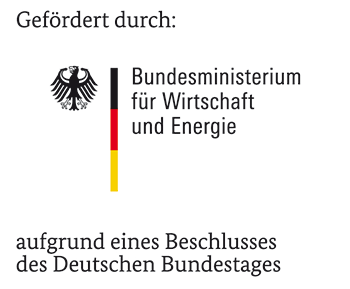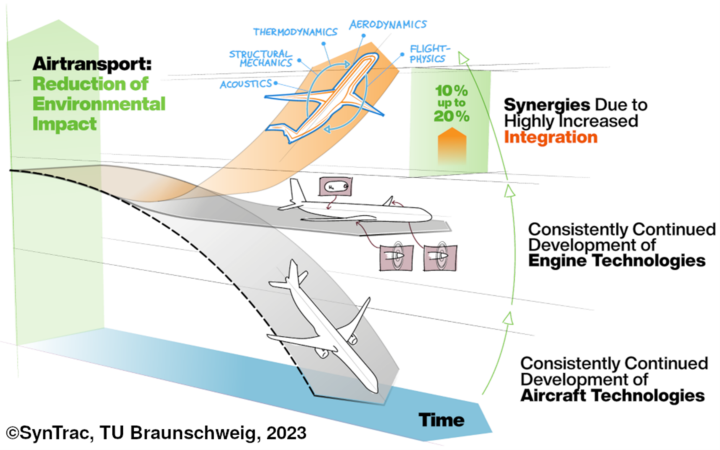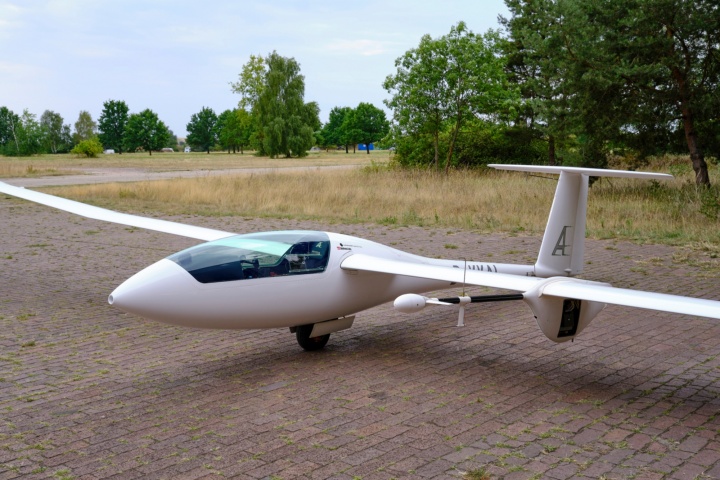Current Projects
With the major goal of climate-neutral flying, we are conducting research on potentials and synergies through highly integrated aircraft development in numerous sub-projects at TU Braunschweig, University of Stuttgart, LUH Hannover and DLR Braunschweig in the new transregio SynTrac collaborative research centre. We use interactions of the disciplines aerodynamics, acoustics, flight physics, structural mechanics and thermodynamics through a multidisciplinary, cross-system view of the aircraft development process to develop future highly efficient aircraft through innovative approaches.
A substantial increase of the overall aircraft efficiency is an prerequisite to achieve the vision of a future climate-neutral air transport system. Hence, the implementation of the Paris Climate Agreement and the European green deal aim for a reduction of aircraft energy consumption of 50% by 2035. Consistently continued development of aircraft and propulsion technologies will contribute significantly to this target. The synergies associated with a highly increased integration of the propulsion systems into future transport aircraft contribute to this target to a similar degree with a potential of 10 to 20% additional energy savings. The team of the laminar wind tunnel will contribute in the means of project B02:
Exploitation of aerodynamic propeller-airframe interactions by integrated design
Project B02 focuses on the exploration of local, unsteady aerodynamic interactions between propellers and laminar wings. In order to increase the overall efficiency of an aircraft, it will be investigated whether a certain laminar run can be retained despite the propeller influence on the wing boundary layer transition. The project is based on high-fidelity CFD simulations using the DLR flow solver TAU as well as time resolved experiments at the laminar wind tunnel.
In addition to investigating regions of boundary layer relaxation in the propeller wake, the effects of the employed propeller on the aerodynamic parameters of an NLF wing under cruise conditions will be examined. Furthermore, an energetic overall assessment of the system will be conducted using the Power Balance Method (PBM).
For more information regarding SynTrac, please visit: https://www.tu-braunschweig.de/syntrac
As part of a contribution to the development and utilization of sustainable energy sources, the Ministry of Science, Research and the Arts (MWK) of the State of Baden Württemberg is funding the joint project autoKite:
Fundamentals of Automated Kite Flight as a Drive for Airborne Wind Energy in the Maritime Sector.
In cooperation with a total of five university institutes, the aerodynamic properties of airborne wind energy systems (AWE systems) are investigated experimentally and modeled numerically at the Institut für Aerodynamik und Gasdynamik. The goal is to develop a method that allows for the precise simulation of highly deformable aerodynamic structures. An essential part for the modeling is the validation by representative wind tunnel measurements.
An incentive for this is the steadily growing demand for renewable and sustainable energy sources. The possibility of using kites as AWE systems at significantly higher altitudes than conventional wind turbines allows a greatly increased wind energy density to be harnessed - especially in regions beyond the near-ground atmospheric boundary layer.
For the efficient deployment and design of kite-AWE systems, it is imminent to understand the dominant aerodynamic parameters. Identical to classical flow bodies, these are significantly influenced by their geometry. In contrast to conventional aerodynamic bodies, however, the AWE systems studied have a flexible membrane surface whose shape is strongly influenced by the flow itself.
In addition to their structural flexibility, the anisotropy and poor scalability of the kite material presents another challenge in the study of the AWE system. Measuring a rigid, scaled-down kite while maintaining similarity parameters, as is common in experimental aerodynamics, would yield results of only limited usability.
With the gust wind tunnel, the Laminarwindkanal working group has an experimental facility at its disposal which allows the measurement of kites at full scale. The influence of aerodynamic forces on the structure of the AWE system will be investigated by using complementary measurement techniques. The aim is to acquire 3D data of the deformed overall structure and the flow variables measured simultaneously.
Recently it has been shown that the turbulence intensity during active convection in the boundary layer of the atmosphere is significantly higher than the turbulence intensity in modern laminar wind tunnels. While the development of all current glider airfoils is based on measurements in such low-turbulence wind tunnels, the actual gliders operate very often in the more turbulent air mass during active convection since gliders have to use thermals to regain height. This apparent dilemma is the subject of current research.
As a part of the LuFo project HPIA, a flight measurement system is developed at the IAG of the University of Stuttgart in cooperation with Schempp-Hirth Flugzeugbau. With this measurement system, transition position, airfoil drag, glide angle and the turbulence intensity of the air mass can be measured simultaneously for the first time. With this measurement system it possible to investigate the flight performance at different levels of turbulence intensity in free flight.
This knowledge of the flight performance in turbulent, unsteady inflow conditions will be used in the further progress of the project to develop a simple design environment for airfoils, which is based on the widely used airfoil design tool XFoil and takes into account the effect of increased inflow turbulence intensity on the airfoil lift- and drag coefficient.
In addition to the investigation of the influence of turbulence on airfoil properties, the aim of the project is the validation of this new airfoil design method. For this purpose, an airfoil design is worked out that takes into account unsteady inflow effects. Further on this new designed airfoil is investigated with wind tunnel and free flight measurements. The aim is to adapt existing airfoil designs to real-life inflow conditions with the lowest possible drag coefficient at high turbulence intensities and not only in low-turbulence conditions.

Finished Projects
Laminar separation bubbles are a crucial phenomenon in the design of low-drag airfoils. This applies to General Aviation airplanes, but even more to UAV, due to their specific range of Re-numbers.
An approximate prediction of separation bubbles is only possible for stationary inflow. There is no scientific foundation for consideration of real inflow conditions, such as turbulence or fluctuating angle of attack, yet. Therefore, nowadays separation bubbles are avoided in a prophylactic, engineering approach, which however reduces the potential drag reduction in cruise, and therefore increases fuel consumption.
The project aims at the investigation of separation bubbles at instationary inflow conditions. The results are supposed to allow better modeling and directly affect airfoil design methods. Improved design methods offer the potential for further drag reduction.

A significant ammount of accidents in general aviation is caused by "loss of control" with subsequent stall and spin, resulting in crashes with fatal injuries.
The ASASys project is destined to develop an Anti-Stall-Assistent-System, which is able to detect impending stall and initiate a counteraction to prevent loss of control. The required pitch down momentum is caused by an additional flap on the lower side of the stabilizer, similar to a split flap, which is developed as an add on for current gliders.
The research on flap and sensor is done in the laminar wind tunnel (LWK), consisting of measurements and calculations
followed by a simulation of the entire system.
The proof of concept will be inflight experiments with a modified glider, fully equiped with ASASys.
Project partners involved are the Flight Mechanics and Controls Lab (IFR, University of Stuttgart) and SFL GmbH in Stuttgart Vaihingen.
Flight through the natural turbulence of the atmosphere results in non-stationary inflow conditions. For aircraft utilizing drag reduction through extended regions of laminar flow the prediction of boundary layer transition is of great importance. However, until now the prediction has been limited to stationary inflow conditions.
The LUFO-LTT project seeks to combine flight measurements, wind tunnel experiments and numerical simulation to improve the understanding of how non-stationary inflow conditions effects the boundary layer and the process of transition from laminar to turbulent boundary layer.
The experimental investigations at the Laminar Wind Tunnel will simulate "real" flight conditions by generating both small- and large scale turbulence to the inflow. The effect on the boundary layer on an airfoil will be measured using hotwire anemometry and fast response surface pressure taps. Specific disturbance modes will be introduced in the boundary layer to map the response in both stationary and non-stationary inflow conditions.
The flight measurements in the project are performed by the University of Darmstadt and the numerical simulations by the IAG at the Stuttgart University.
The reduction of interior noise gains in importance in the automotive industry. Thereby, particular interest is focused on the elimination of disturbing tonal components deriving from the side mirrors. While most tonal noise sources are avoided by specific design guidelines, some side mirrors exhibit tonal self-noise emission, where the underlying source mechanisms are largely unexplored. In this context, experimental investigations of the tonal self-noise emission from a conceptual AUDI A7 side mirror model are performed in the Laminar Wind Tunnel. In order to identify the underlying source mechanism, the flow topology is investigated using steady and unsteady pressure measurements, hotwire anemometry and particle image velocimetry. Furthermore, a flush-mounted microphone array and an in-flow microphone are used to determine the characteristics of the tonal noise emission.
Surface roughness close to the leading edge of wind turbine blades caused by insects or surface erosion, for example, can significantly shift boundary-layer transition upstream. This leads to a considerable increase in aerodynamic resistance and thus to a reduction of power generation.
The aim of the experimental investigations in the Laminar Wind Tunnel is to gain a better understanding of the interaction of single, three-dimensional roughness elements with a laminar boundary layer. The inflow conditions of wind turbines in the experiment are achieved by a controlled introduction of boundary-layer disturbance modes upstream of the roughness elements. In the experiment, essential parameters such as roughness shape and height, pressure gradient and inflow conditions are specifically varied in order to determine their influence on the existing transition mechanism and the transition position. The use of two complementary measurement techniques (Particle Image Velocimetry and Hot-Wire Anemometry) achieves a high spatial and temporal resolution of the flow topology in the vicinity of the roughness elements. The experimental investigations will be complemented by Direct Numerical Simulations (DNS) performed at the Laboratory of High Performance Computations at the University of Sao Paulo.
This research project aimed at the further development of acoustic measurement methods for determination of noise emissions from airfoils.
The focus was laid on measurement of trailing edge noise, often representing the dominant noise source e.g. on wind turbines and subsonic wings. Particularly, techniques for use in aerodynamic, typically "noisy", wind tunnels were developped to allow practical application. The combination of aerodynamic and aeroacoustic measurements in one wind tunnel offered advantages with respect to the quality and consistency of the obtained data. Challenging was the separation of the desired acoustic signals of the model from the background noise of the wind tunnel, especially if it is not acoustically optimized.
Two strategies were studied in more detail: I.) a microphone In-Flow-Array and II.) the direct measurement of the particle velocity by a special hot-wire arrangement. The two methods complement one another in that way, that the microphone array allowed a good spatial resolution whereas the hot-wire method covered a large frequency range.
Open points of the methods with respect to the determination of quantitative values should be cleared and possible improvements concerning the signal-to-noise ratio were investigated and realized. The combined use of two different methods on the one hand allowed the exploitation of individual advantages and on the other hand the mutual validation of the complex measurement procedures.
The project was conducted in cooperation with the Institute of Theoretical and Applied Mechanics (ITAM, Novosibirsk).
In the framework of the EU-project SIROCCO we were involved in the design and testing of airfoils with a low noise radiation. The development of low noise airfoil sections is one of the major tasks in future because of its strong impact for example on the acceptance of wind farms. The aerodynamic measurements at the Laminar Wind Tunnel were extended by aero-acoustic measurements. Several modifications were made to reduce the noise emission of the tunnel itself and a new measurement procedure (CPV-Coherent Particle Velocity method) was developped for in-flow measurements of the trailing edge noise.
Weakly nonlinear stages of the transition process were investigated in a joint DFG-RFBR (Russian Foundation of Basic Research) project. At this stage resonant interactions occur between instability waves which are leading to a strong amplification of waves within a wide frequency range. This amplification is dominated by the amplitude of the fundamental wave frequency and the growth rates are much stronger than the pure exponential growth of the fundamental wave. As a result the formation of secondary structures in the laminar boundary layer and finally the transition into a turbulent boundary layer is initiated . The project was finished in September 2005.
In the field of basic research extensive experimental investigations on laminar-turbulent transition is carried out. In the framework of the DFG (German Foundation of Basic Research) key project 'transition' (which was finished in 2003) we concentrated on receptivity mechanisms of laminar boundary layers, the first step towards transition. Measurements were performed under controlled disturbance conditions which gave insight into the transformation of outer disturbances (sound, vibrations and turbulence) into inner disturbances (i.e. Tollmien-Schlichting waves) of the boundary layer. Within this project we established a strong cooperation with the transition group at the Institute of Theoretical and Applied Mechanics (ITAM) at Novosibirsk. The final results of the measurements were compared to Direct Numerical Simulations (DNS) performed at our Institute.
Contact

Ulrich Deck, M.Sc.
Head of working group Laminar Wind Tunnel




